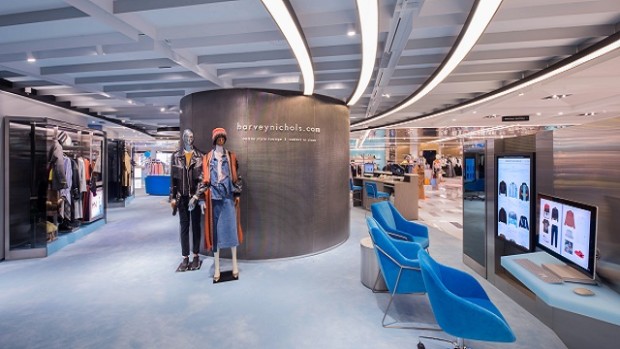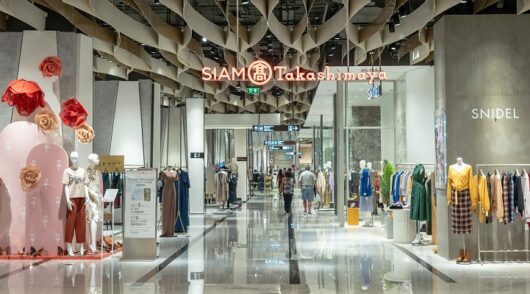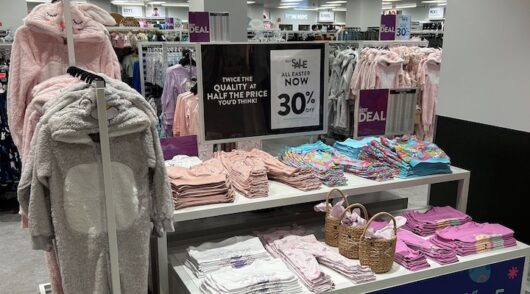
At Hong Kong’s Admiralty, UK luxury department store giant Harvey Nichols unveiled a retail concept in September last year that it hopes will win favour from online shoppers and enhance the experience of customers at its bricks-and-mortar store.
With flagship stores from international brands and pureplay retailers providing tough competition for department stores all over the world, Harvey Nichols, which holds stores in the UK, Middle East, Turkey and Hong Kong, has not been immune to the trend.
“We see the retail landscape changing a lot in the sense that online, you have very strong competition from the pureplay retailers who are obviously extremely aggressive. And a lot of them are very successful now and engaging customers, especially younger ones,” explains Pearson Poon, executive director of Harvey Nichols.
“We really believe customers will not shop only online, and that the [physical] store is still very important.”
In the mix
But Poon accepts that stores have to undergo a transformation to meet
the challenge.
“In the past, maybe a lot of department stores could rely on a few brands and the customers would come because of that. But in today’s world, that strategy is quite difficult,” he notes.
“A lot of the major designer brands have very big flagship stores now. So if you’re a customer looking for a specific brand, the best place to go is a huge flagship store where you can have the biggest offering from that particular brand, and have someone knowledgeable about the brand serving you.
“We really felt that we needed a store that customers would come to, not just because they’re looking for a particular brand, but because they really enjoy the experience and the product offer.”
These days, department stores have both an online platform and physical stores. Normally the product ranges across both are identical or at least extremely similar. But the overlap between the new Harvey Nichols store’s stock and the retailer’s online range is just 10 per cent.
“As a result of all this, we’re essentially able to reduce our physical space by half, to 3700sqm, but at the same time, triple the number of products we can show to our customers. We really focused the store on discovery and exploration,” explains Poon.
“We think this is a much more interesting and fun way to shop. We think it’s the first of its kind, certainly in Hong Kong and probably elsewhere in the world, in terms of how we’re showing the online and offline products within one space and really making that the heart of the store.
“Online, we focus on our international offering and inside the stores, we focus on a lot of new emerging brands and local offerings.”
In-store, those brands include upcoming Japanese and South Korean brands yet to establish the sort of top-of-mind brand recall which would enable them to sell in high volumes online.
One example is South Korean menswear label Wooyoungmi, which the retailer was the first to expand across the region and beyond.
“It is now one of our most successful menswear brands,” Poon explains. “When you have products like that, and customers come in and find something they have never seen before, that’s something they really like.”
Customers are now shopping at Harvey Nichols not because they are looking for a particular brand, but because they know that every time they come in, they can find something new.
Looking from the outside in
So how do you lure visitors into a physical store to peruse a vast online catalogue in an engaging and relaxed manner?
Digital screens are key at Harvey Nichols Pacific Place. It begins outside where an interactive screen is built into the shop window, allowing customers to browse products online.
“You can click on any product that you see on the touch screen, then a model wearing that product will show on screen right away. So even before the customer enters the store, we really hope to engage them,” Poon says.
It’s what he describes as “cross category”. Shoppers can assemble a complete outfit if they wish, including top, skirt, shoes and handbags and view them all together.
That screen solution is replicated in-store, where a stylist on duty can also recommend items that might match or suit the shopper, adding a more personal touch to the experience.
Throughout the store, some racks have been replaced with screens, most of them around 1.27m, as the size offers the closest simulation to the real size of the apparel. Using their phone, a customer can scan a product’s QR code from the screen and immediately view different angles of the item, along with details like the fabric composition, size and fit.
Going global
Designed by Studio Four IV, the new Pacific Place format is a trial which, once fine-tuned, will be introduced around the world.
“Before jumping into a big expansion spree straight away, we thought we would open this and take some time
to gather customer feedback on it.
We’ve never done something like this before, and we don’t think there are a
lot of other retailers we can refer to,”
says Poon.
“We don’t have any particular country or geography in mind. We don’t have a store in mainland China at the moment, or one in Japan. So I think once we have data from how the Pacific Place store is trading, we will be in a position to see where else we should go internationally.”
Meanwhile, while most of Harvey Nichols’ online business is currently coming from the UK, the company ships globally and solid growth is showing in purchases from greater China and the US.
“That gives us the confidence to continue to pursue growth for online. I think what’s interesting about this is that, especially in new markets, where we may be lesser known, such a store would also create awareness of our online platform in that particular country,” he says.
“I think the physical space is important. And even if you don’t have a physical space, I think the human interaction between a customer and a personal shopper or a stylist is important.”
One decision the Harvey Nichols team made early on was that technology installed in the store must have a customer-friendly purpose.
“As part of planning the store, we evaluated many, many different pieces of technology and hardware. But ultimately what we have here is really based on what we think can deliver our proposition in the best way. There is a lot of tech out there that doesn’t really enrich the customer experience. And we don’t want to overwhelm the store with screens,” reflects Poon.
“In today’s world of retail, with so many changes, we really need to make the physical store environment a very engaging and fun place to shop. Otherwise, it’s difficult to retain customers in a physical store environment.
“The whole motivation behind this store is really building a format that we think is suitable for today’s retail world.”





